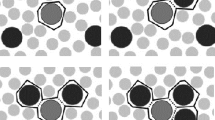Abstract
Cellular automata models of solubilities in a solvent (water) have been dynamically synthesized. Rules relatingwater‐water, water‐solute, and solute‐solute relationships have been systematically varied in order to assess their influence on the emergent property of solubility. The results reveal the prominent influence of rules governing the probabilities of solute‐water joining and breaking. This influence manifests itself in significant changes in the emergent properties of relative solubility and solubility changes with water“temperature”. The study demonstrates the validity and potential value of cellular automata to model solution phenomena.
Similar content being viewed by others
References
J.D. Bernal and R.H. Fowler, A theory of water and ionic solution, J. Chem. Phys. 1 (1933) 515.
G.B. Ermentrout and L. Edelstein-Keshet, Cellular automata approaches to biological modeling, J. Theor. Biol. 160 (1993) 97.
D. Farmer, T. Toffoli and S. Wolfram, eds., Cellular Automata, Physica D 10 (1984).
A. Geiger, F.H. Stillinger and A. Rahman, Aspects of the percolation process for hydrogen bond networks in water, J. Chem. Phys. 70 (1979) 4186.
J.M. Haile, Molecular Dynamics Simulation(Wiley, New York, 1992).
L.B. Kier and C.-K. Cheng, A cellular automata model of water, J. Chem. Inf. and Comp. Sci. 34 (1984) 647.
L.B. Kier and C.-K. Cheng, A cellular automata model of an aqueous solution, J. Chem. Inf. and Comp. Sci. 34 (1994) 1334.
L.B. Kier and C.-K. Cheng, A cellular automata model of dissolution, Pharm. Res. 12 (1995) 1521.
L.B. Kier, C.-K. Cheng, B. Testa and P.-A. Carrupt, A cellular automata model of the hydrophobic effect, Pharm. Res. 12 (1995) 615.
L.B. Kier, C.-K. Cheng, B. Testa and P.-A. Carrupt, A cellular automata model of micelle formation, Pharm. Res. 13 (1996) 1419.
L.B. Kier and B. Testa, Complexity and emergence in drug research, Advances in Drug Research 26 (1995) 1.
M. Mezei and D.L. Beveridge, Theoretical studies of hydrogen bonding in liquid water and dilute aqueous solutions, J. Chem. Phys. 74 (1981) 622.
S.A. Rice and M.G. Skeats, A random network model for water, J. Phys. Chem. 85 (1981) 1108.
R.J. Speedy, Self-replicating structures in water, J. Phys. Chem. 88 (1984) 3364.
H.E. Stanley and J. Teixeira, Interpretation of unusual behavior of H2O andD2O at low temperatures: tests of a percolation model, J. Chem. Phys. 73 (1980) 3404.
S. Wolfram, Statistical mechanics of cellular automata, Rev. Mod. Physics 55 (1984) 601.
W.H. Zachariasen, The atomic arrangement in glass, J. Am. Chem. Soc. 54 (1932) 3841.
Author information
Authors and Affiliations
Rights and permissions
About this article
Cite this article
Kier, L.B., Cheng, C. A cellular automata model of the soluble state. Journal of Mathematical Chemistry 21, 71–81 (1997). https://doi.org/10.1023/A:1019106015749
Issue Date:
DOI: https://doi.org/10.1023/A:1019106015749




